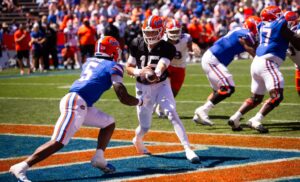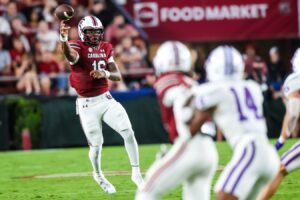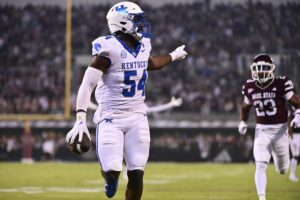Let me first preface this article by stating that as a former college football player, player safety is very important to me. I want everyone that plays football to live a long, happy, fulfilling, and most importantly healthy life whenever their football careers end. To see all these former players suffer from Chronic Traumatic Encephalopathy (CTE) is heartbreaking. Seeing NFL players like Chris Borland retire early because of concussions is heartbreaking. After stating where I stand on player’s safety, I want to now discuss a tragedy of a rule in College Football. That rule is Targeting.
What is the Targeting Rule?
Part of the problem with the rule of targeting is that there are two definitions of Targeting, although neither is very clear. The following definitions are taken straight from the NCAA rule book. For further clarity on NCAA rules click here.
Targeting and Making Forcible Contact with the Crown of the Helmet
ARTICLE 3. No player shall target and make forcible contact against an opponent with the crown (top) of his helmet. When in question, it is a foul. (Rule 9-6) (A.R. 9-1-3-I)
and
Targeting and Making Forcible Contact to Head or Neck Area of a Defenseless Player
ARTICLE 4. No player shall target and make forcible contact to the head or neck area of a defenseless opponent with the helmet, forearm, hand, fist, elbow or shoulder. When in question, it is a foul (Rules 2-27-14 and 9-6). (A.R. 9-1- 4-I-VI)
Do any of those definitions seem clear to a defender who is trying to find the clear strike zone of the offensive player in a split second? Even referees are having a hard time distinguishing Targeting. Here are some examples of poor calls.
Video Review
The first clip is a missed Targeting penalty, the defender clearly intended to use the crown of his helmet against a defenseless player and makes contact to the ball carriers head/neck area.
The second clip, was called targeting and the ejection stood, but note that the player never uses his helmet as a weapon nor makes any forcible contact on a defenseless receiver. He just makes a good clean form tackle.
Targeting is a rule that, in theory, sounds good because it takes out some of those vicious hits that makes fans turn away. It should help keep the game safer, but those big vicious hits that fans are scared of are a rarity. Players can go an entire career without ever experiencing those types of hits. If the NCAA wants to truly help the student-athletes, it can start by providing their student-athletes with insurance for after graduation. But that is a whole different story. The other problem with the rule of Targeting is the punishment and enforcement of the rule.
Replay and Sit
After a player is flagged for Targeting they are penalized fifteen yards and the penalized player is ejected. If the foul occurs in the second half of a game, the penalized player must sit out the first half of the next game. That means a player who is ejected for Targeting on the first play of the second half is penalized the same as someone who is ejected on the last play of the game. Only the player ejected on the first play will essentially miss a whole game. The punishment needs to be scaled down to the current game if at all. All Targeting penalties are reviewed by the replay officials.
Stop and Review
In 2016, the NCAA passed a rule that allows replay officials to stop the game and review any hit for a potential Targeting penalty. The problem with this is that it comes off as a witch hunt to find targeting penalties where they don’t exist. The original rule states that “When in question, it is a foul.” If the referees on the field do not have a problem with a hit in live time, then how was the hit ever in question?
Let it go
Football is no longer a contact a game, it is a violent game. The players that play it are aware of it, as are the coaches who coach it. Yes, the game can and should be safer but the NCAA cannot create a safer game by creating a rule that is unclear and then having an enforcement policy that is a near witch hunt and punishments that do not fit the penalty. It’s time the NCAA let the Targeting rule go; the game of College Football will be better for it.
Main Photo:






